The popularity of resin 3D printing is still pretty new, and there are still many unknowns about its byproducts. There are dozens of varieties of resins, all with different characteristics that can affect the quality of the print Every color under the rainbow, ABS-like resin, water-washable, rapid, plant-based, and more are obviously made from different chemical compositions, and we don’t have a very clear idea of what’s in all of them. Today we’re going to take a look at a potential solution that aims to remove some of the potentially harmful chemicals we might encounter as we bring awesome statues and figures to life using only a bit of resin and some light. Let’s deep dive the Elegoo Mars Mate.
Before we get started, there are a handful of terms to know that you might see or hear when researching resin 3D printing, the first of which being VOC. VOC stands for volatile organic compounds, a grouping of chemicals that can be harmful of inhaled including (but not limited to) benzene, ethylene glycol, formaldehyde, methylene chloride, tetrachloroethylene, toluene, xylene, and 1,3-butadiene. It doesn’t take a chemical engineer to know that none of those things are likely good for your lungs. The second term is TVOC, or Total Volatile Organic Compounds. While they sound like the same thing, TVOC is the measurement of gas per classification and the sum of all gasses in a space. That is to say, it’s your overall air quality and its component parts. TVOCs are typically used to measure the amount of toxins in an enclosed space, such as the room where we’ll be performing our 3D printing.
In all of my videos I’ve been extraordinarily clear about the need for proper personal protective equipment such as respirators, but not everyone is either aware or heeds those warnings. In the space where I’m testing I have four active resin 3D printers, one combined wash/cure station, and one that is separated into two – a wash station and a cure station. All of my filament printing is done elsewhere. To measure the overall effectiveness of the Mars Mate, we’ll look at measurements from a variety of locations and conditions to try to effectively create a “control” case. I don’t have a clean room to start from, but let’s just call my house “normal” and go from there.
Your household actually contains a number of VOC-emitting items. All of the solvents and cleaners under your sink, dishwashing detergent, bleach, shampoos, deodorants, fabric softeners, dryer sheets, floor cleaning solutions, wood polish, adhesives, and even the air fresheners we use to try to mask all the smells from this list all contain some level of emissive chemicals including acetaldehyde, phenol, methylene chloride, formaldehyde, limonene, benzene, phthalates, toluene, and more – it reads like a horror show. And to think, these are things we use to clean other things! In small doses, it’s unlikely these will hurt you, but over time they can be toxic, but what does the scale look like? Any sensor we’d use measures the milligrams of VOC per cubic meter of air, which is why all of the results appear as TVOC mg/m3. Here’s an easy four-point range we’ll use in our testing.
Safe levels – : .03-0.5 mg/m3
Potentially Dangerous Levels: 0.5-1.0 mg/m3
Highly Dangerous Levels: 1.0-3.0 mg/m3
You fell into Blighttown. You died: 3+ mg/m3
Ok, the last one is a joke, but you can see that it doesn’t take much to move into dangerous territory when it comes to these chemicals. Let’s start with control.

You can see that we are at 0.015 mg/m3 TVOC – below the safe scale when measured all the way across the house from my printer lab.
Heading into the lab, I currently have four resin 3D printers – a Saturn 3 Ultra, Saturn 4, Saturn 4 Ultra, and a Jupiter LE. For the Wash and Cure station, it’s the largest Anycubic station, currently filled to around 6000 ml of 99% Isopropyl alcohol – slightly more than half its capacity. The secondary wash and cure station is the Mercury X which separates out both functions. That one is filled to around 5000 ml of 99% Isopropyl alcohol, again roughly half. The Anycubic is, to be frank, filthy. It’s the first wash station my prints go through and the resin there is gross most of the time as it’s my initial bath, shedding most of the loose resin from the print. The Mercury X is almost clear as it handles my second pass cleaning work.
I mention the cure station as the act of curing a print is also a chemical reaction. As a rule, after I run my prints through both cleaning processes, I leave them on a set of paper towels to vent for 12-24 hours. This results in a far cleaner print that holds paint easier and generally comes out without any residue. Those are being vented to the air, so they contribute to the TVOCs for the space. At this point, no additional toweling is required, and they never come out slick or sticky. From there you cure them using a UV light tuned somewhere between a 365 and 405 nm wavelength, depending on the material. This essentially “cooks” the liquid photopolymer, cross-linking and hardening the chemical structure – a process called photopolymerization. Does it put anything into the air? I’m not 100% sure (and I don’t think the meter I have is sensitive enough to see it – I detected no additional VOCs), but I’d have to imagine so. Either way – it’s in the room, it gets measured.

(I moved the FDM printer right after this shot. I also cleaned. What an embarrassment)
The Mars Mate is a very simple device. Measuring 8.27″D x 9.72″W x 16.14″H, it stands roughly ¾ the height of the Saturn 3 Ultra printer in the center. Opening the top, it’s surprisingly a mostly empty container – the bulk of the unit is the large replaceable activated carbon cartridge. Sorry for the repeated chemistry lessons, but activating carbon is the process where you apply high temperature to charcoal, allowing the internal structure to expand to a porous nature. This allows the charcoal structure to develop a surface area capable of trapping chemicals and gasses through a process called adsorption. These gasses are accumulated inside and onto the surface of the carbon, removing the contaminant from the air. In this case, it does so by pulling the air through the carbon via a low-powered 6W fan, keeping it very quiet (at just 35dB), but all of this leaves us with the nagging question…
Does it work?
Elegoo advertises “The purifier has a built-in activated carbon filter, which can effectively absorb formaldehyde and odors, with a purification rate of up to 95%.”, giving us precisely what we needed for a more scientific measurement. We have X (our control above), and a Y (95% reduction), meaning we just needed the upper bounds (the hood open) to see if it delivers on the promise. X to Y and by how much. Let’s measure.
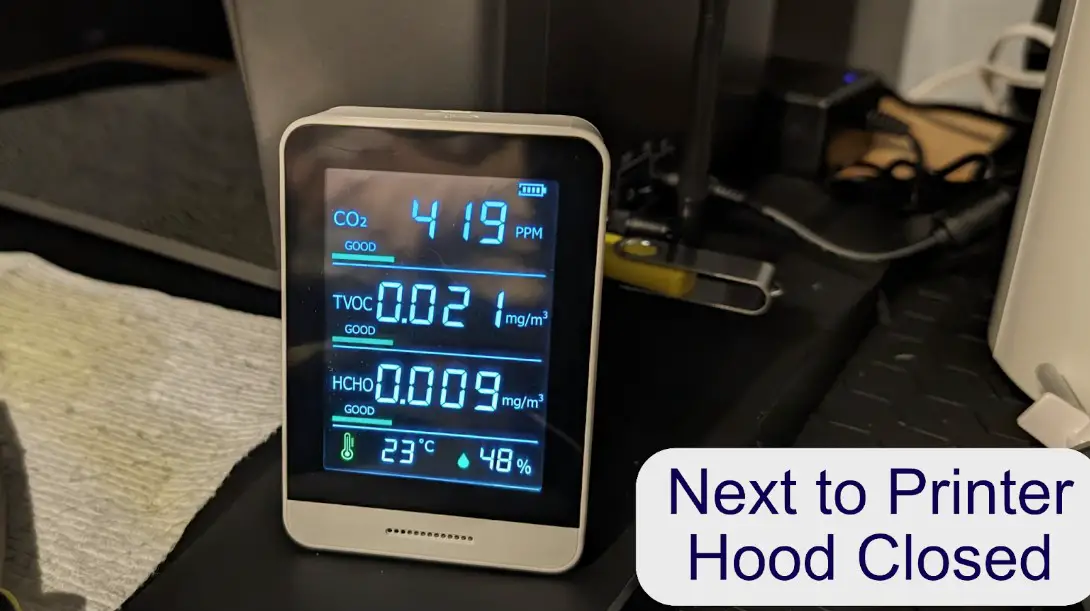
I wanted to add one more measurement before I got started to answer another question – is it safe to be around your 3D printer with the printer full of resin, but with the hood closed. To answer the unseen question, yes – I removed all of the resin tanks in the room but the one in the Saturn 3 Ultra for these tests, though I did leave the IPA as it made no measurable difference in the measurements.
The first outcome is obvious by the reading – yes, there is some leakage of VOCs with the hood closed. It’s not much, but it is here, moving up from 0.15 to 0.21 mg/m3, a 40% increase. Let’s look at the scale again for reference:
Safe levels – : .03-0.5 mg/m3
Potentially Dangerous Levels: 0.5-1.0 mg/m3
Highly Dangerous Levels: 1.0-3.0 mg/m3
You fell into Blighttown. You died: 3+ mg/m3
The meter we’re using clearly states that the TVOC is still within the “GOOD” range, and the widely-accepted range upper bounds of safe are 0.5. We are miles away from this value. The deduction here is that you can safely be around your 3D printer with the hood closed without danger to your lungs. You might still detect a smell here, but I’ve found that to be something that anecdotally varies wildly between observers. Your mileage may vary here. Let’s open the hood.
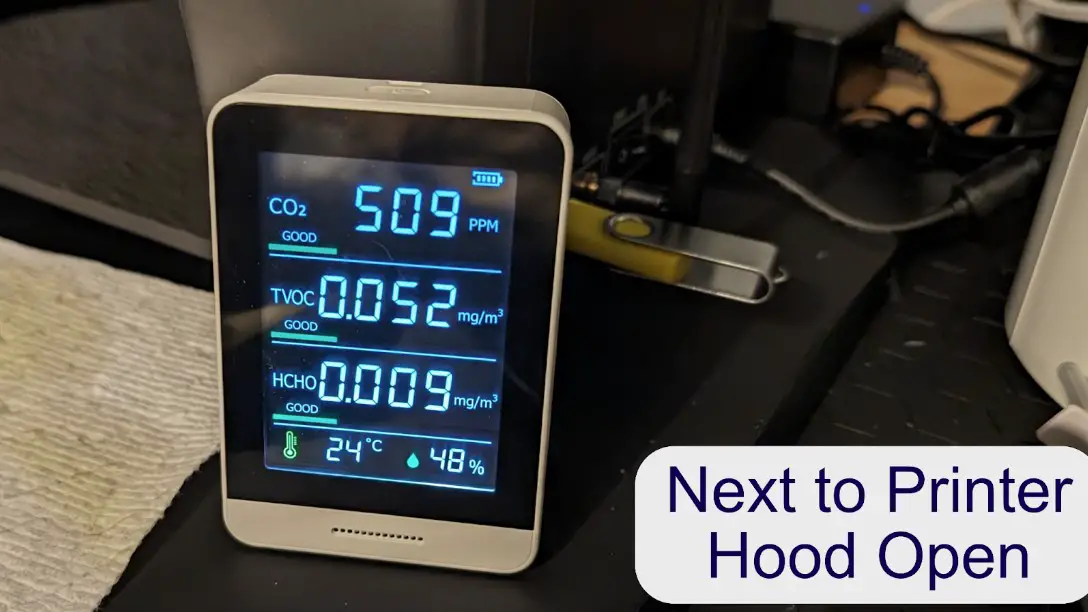
Within a minute of the hood being open, we are at 0.052 mg/m3. Surprisingly, this is still WELL within the safe range, the increase is a whopping 247% over the control. There’s no doubt that this is a sharp increase to be sure, but it wasn’t the jump to Blighttown that I expected. It wasn’t even a jump to potentially dangerous, surprisingly. I left the hood open for a full 30 minutes to see where things landed.
It was time to get absolutely dumb about this to see if it’s even possible to get to Blighttown levels.
I cracked open multiple resin types and from various vendors. You can see that the numbers began to jump into the red, topping out at around 0.87 mg/m3, nearing the top end of the “Potentially Dangerous” levels category. What would it take to drive this to max out? It turns out that the threat to your lungs isn’t from resin, but from something you might not have thought about – isopropyl alcohol.
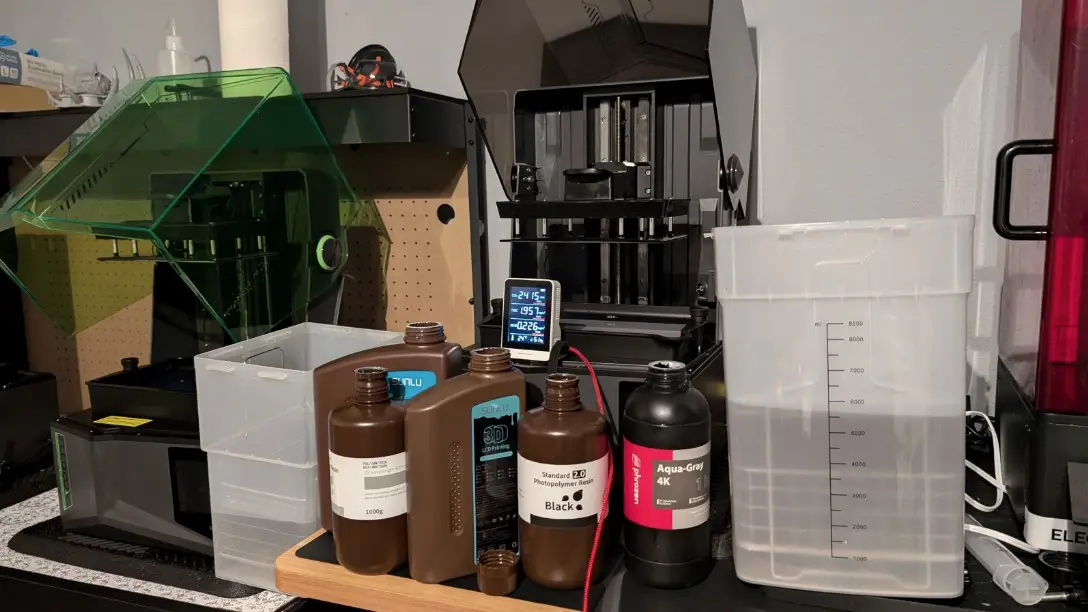
It turns out that the meter I’ve purchased tops out at two, squarely in the middle of “Highly Dangerous”, and it reached that value almost instantly once I opened my cleaning vats. Clearly IPA throws dangerous amounts of VOCs into the air at an alarming rate. Based on the speed at which it did so, I can only assume we were well within Blighttown levels, though I couldn’t readily prove it with the meter I had on hand. I was curious, however, whether it was possible to reach levels this high with just the printing process? It turns out the answer was yes, but I was surprised at how that happened.
As we saw earlier, the hood open or closed on a single printer barely cracked into the “Potentially Dangerous” level. There is just enough room for my meter to fit inside the Saturn 4 Ultra as it prints, so I thought for completeness sake I’d try one final test. The plate descended and the meter barely moved, just as before. It lowered, self-leveled, sank into the resin, and the first layer began to print.
Instant Blighttown.

The meter didn’t climb to 2.0, it slammed there in the span of less than three seconds, and there it remained. As the initial layers cooked, the chemical process of the light and resin interacting and hardening apparently released VOCs at an alarming rate. The meter moved from 0.29 to 1.707 mg/m3 TVOC, as well as ramping the CO2 to 2245 PPM, and HCHO to 0.214 mg/m3 — hovering around the same values that we needed ever open bottle and two vats of open IPA to achieve, only this time being achieved by a single printer! Having shown that the printer was more than capable of fouling the air in a very real way, now was the time to see what the Mars Mate could do..
Installation of the Mars Mate is remarkably simple. Elegoo lists that it is compatible with Elegoo Saturn 2, Elegoo Jupiter, Elegoo Saturn 8K, Elegoo Mars 4 DLP, Elegoo Mars 4 Max, Elegoo Saturn 3, Elegoo Saturn 3 Ultra, but it also installs cleanly on the Elegoo Saturn 4 and Saturn 4 Ultra. I believe it’ll also install on the Jupiter LE, though I didn’t test that. Four small hex bolts hold a small plate in place, removed with the included Allen wrench. With the port open, you’ll use the included longer bolts to secure the adapter to the back of the printer, providing a port with a rubber seal for the tubing to interface.
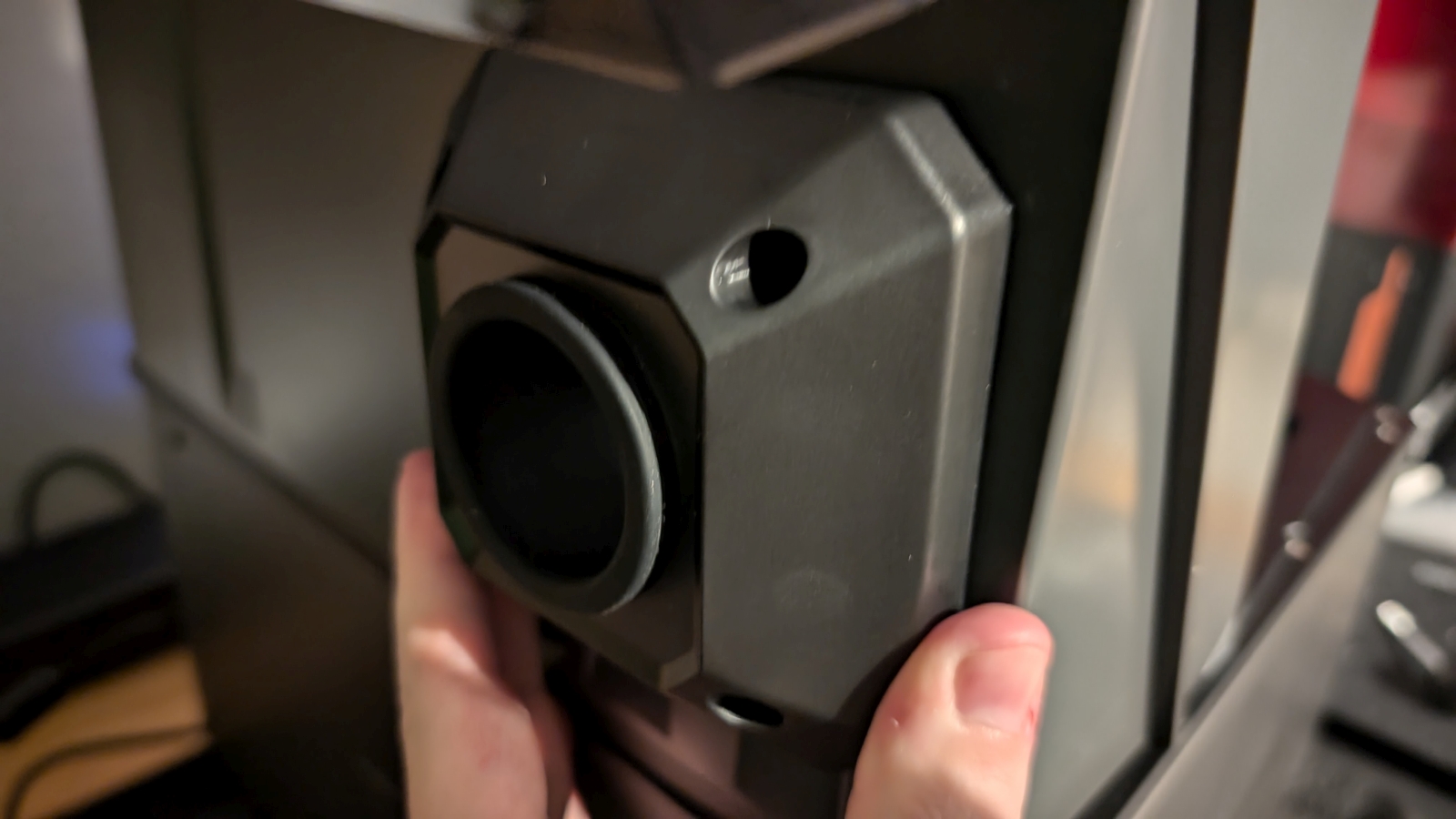
The tubing itself is a metal-lined flexible tube, with an equally flexible plastic exterior. It’s roughly 3.5 feet long, with a slightly flared end to create an adequate air tight seal. Pressing it into the back of the printer, and then into the back of the Mars Mate, it was ready to go. It really is that simple.
The whole system runs on just six watts of power – enough to run the small fan and a bank of sensors. The fan runs at either high or low speed, automatically switching as the TVOC values demand. With the levels as high as they were, both fans kicked on the second I turned on the Mars Mate. What was surprising was just how fast it rectified the issue.
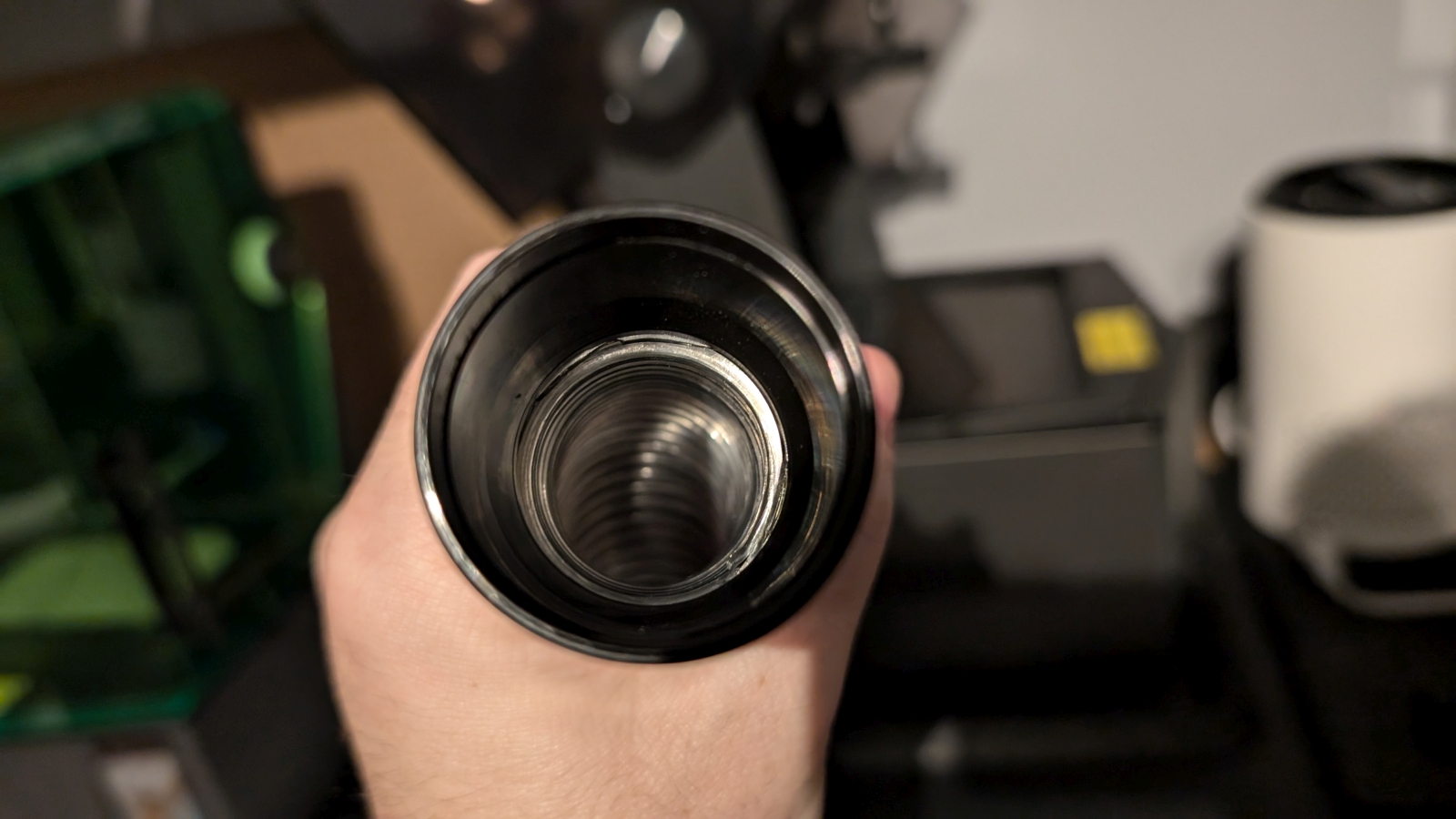
In the span of roughly 75 seconds, the TVOC levels were back to 0.5, and at roughly 3 minutes, had fallen to 0.29. It had also reduced the CO2 load to 927 PPM (the “OK” range) and HCHO to 0.052 mg/m3 — well within the “Good” range. It also did so without sounding like a jet engine, with fan sound levels measuring just 35 dB – a whisper. While Elegoo advertised an “up to 95% reduction in TVOCs”, it’s clear that this estimate was conservative, and something the machine exceeded easily.
All of this reduction is achieved with activated carbon, as I’d mentioned. Elegoo says that this carbon will last “roughly two months”, but before that causes you panic, that’s two months of printing time. Two months is 1,460 printing hours. Though I have yet to reach that time, the manual advises that the Mars Mate has an indicator to let you know when you’ve reached near that amount so you can replace it. This consumable is proprietary, meaning you can only get it from Elegoo (and by extension, Amazon), and at the time of writing will set you back $94.99 – a fairly large chunk of the device’s total $158.00 sale price (MSRP is $197.50).

We set out to answer a basic question of “Does the Mars Mate just make the room smell better, or does it actually remove VOCs from the air?” While the argument has been made that only a large commercial air handler can do this, we’ve proven at least to some degree that the Mars Mate meets the challenge. Yes, my room smells significantly better, but by my measurements it can also pull the toxins away from the printer during the resin/light chemical reaction. Our testing also revealed something far worse, though.
During my printing process, I’ve always been wary of resin. After all, it causes intense burns on some folks, it smells awful, and the bottles are covered in warnings. Once I’d pulled my prints off the plate and gotten it back in the machine, I’d swap gloves, take off my respirator, and continue with my prep work. The supports come off, it goes in the first resin bath, it gets the first few layers of cleaning (often with the lid off as I don’t keep enough in the vat to splash), then I’d pull up the basket, retrieve the items, and run them through my cleaner IPA bath to ensure they were as clean as possible. I’d then let these vent their gasses for at least 12 hours before curing them. I never thought about just how much harm I might be doing to my lungs with isopropyl alcohol – something the Mars Mate obviously won’t solve. There is a real threat there, and one that I’ll now be paying a great deal more attention to in the future.

















